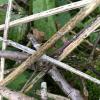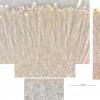
29-12-2025 08:30
Hello.A tiny ascomycete sprouting under Juniperus

29-12-2025 10:15
Hulda Caroline HolteHello, I found and collected this propoloid ascom

29-12-2025 09:38
Oskari VirtanenHi,could anyone help me identify this, I suspect P

28-12-2025 12:08
Margot en Geert VullingsThis possible Karstenia was found on the bark of d

21-12-2025 21:32
Pol DebaenstHello, Garden, Burgweg 19, Veurne, BelgiumOn 10/1

26-12-2025 21:19
Arnold BüschlenPithyella chalaudii Priou. Ist als Bryoparasit in

21-12-2025 09:32
Hello.A tiny ascomycete found embedded in wood in

18-12-2025 21:17
Pol DebaenstThe identification took me to Byssonectria deformi
Habitat: On standing dead stems of Urtica dioica from last year, found on the lower part of the stem but not the base, seems more common in shady areas, often where dead stems are touching, collected from a small hilltop woodland of mostly Rosaceae, Prunus cf. avium and Crataegus monogyna, South Downs, England, early April, after rain.
Associates: Very small black spots – possibly Leptosphaeria sp.
Apothecia: Often one hundred or more on a stem, in several loose groups, gregarious to 2-4-caespitose, sometimes overlapping, small, (0.2) 0.4-0.7 (0.9) mm diameter, erumpent but not always clear when mature, initially ellipsoid, receptacle apparently open early, then discoid to cupulate when mature, sessile, bright orange, grainy appearance, firm-gelatinous texture; margin often raised, uneven, brownish, not clearly distinguished from the receptacle; disc lighter, plano-concave.
Storage and methods: Short pieces of host stems stored with some damp moss in a fridge overnight, central sections taken from two mature-looking apothecia, mounted in water, IKI added to water mount, KOH + CR added after IKI. First erumpent apothecia I have examined, not sure if I needed to rehydrate more or it was too cold in the fridge, but hymenium and asci were surprisingly opaque.
Asci: Cylindrical-clavate, croziers, IKI -, apex rounded to acute, relatively small compared to spore size.
Vital: ~70-82 x 8.5-10.5 um, 1-2-seriate, one or sometimes two spores at apex, little to no thickening visible, noticeably protruding from epithecium when mature, pars sporifera ~30-40%.
Dead: ~62-70 x 7-9.5 um wide, significant loss of turgidity in mature asci, more clavate when mature and often irregularly shaped due to relatively large spores protruding, pars sporifera > 40%, 1-2.5-seriate, small lens shaped thickening < ~1 um high, apex more acute-obtuse, more noticeable when immature, in IKI mature spores with red contents including nuclei (possibly more transparent areas).
Spores: Broad-cylindrical to ellipsoid, curved in profile view, uniseptate when mature in ascus, usually heteropolar with the base/basal cell narrower, many small shadowy LBs around each pole, appear to surround the nucleus and then disperse to the edges.
Mature vital spores measured in water mount or IKI in dead mature asci: 15-17.7 x 3.2-4.9 um, Q = 3.3-4.7, n = 9, mean = 16.1 x 4.2 um, Q mean = 3.9.
Conidia?: Smaller, aseptate, ellipsoid-ovoid, found on flanks and in epithecium, once chain of two observed.
Paraphyses: Narrow-filiform, apices rounded, and uninflated to clavate ~1.5-3 um wide, many small LBs, challenging to see in the hymenium and to determine septation.
Exudate: Rose-orange all over; epithecium thick, cloudy, greyish and grainy appearance at high magnification; around margin and flanks more concentrated, clumpy, dark orange-brown, apparently sometimes covering edges of hymenium.
Ectal ex.: Textura globosa, small cells, appears very reduced and mostly around base, base and lower flanks immersed in the substrate and edge appears uneven.
Marginal cells: Hypha-like on flanks, parallel to each other and the surface, multi-septate, protruding parts like paraphyses, not observed protruding above hymenium.
Medullary ex.: Separated from ectal by medium-size band of horizontal hyphae (leading to the marginal cells), textura globosa like ectal ex., appears to represent most of the receptacle.
Subhymenium: Appears very reduced, some swollen cells close to the ascus bases.


The black pyrenomycete at the Urtica stem base is most probably Leptoshaeria acuta
I wonder if there is a vernacular name in English for this fungi as in France it is : la rougeole de l'ortie ( Nettles measles)
And thanks again
Amitiés Michel
I was suprised that this species appeared to be called many names, but I saw all the names together in the folder. On Species Fungorum, I saw the three independent definitions (with Tremella urticae Pers. as the oldest). At least it seems like a helpful specific epithet.
The descriptions may seem like overkill, especially when the species is rather obvious, but hopefully I'm learning from it. It also encourages me to observe everything more carefully, and try to improve my microscope work. It reminds me of a comment by Huhtinen that I read recently, suggesting that a lot of time and effort is spent collecting but relatively little at the microscope afterwards.
I read that there are two similar looking species of Leptosphaeria reported on Urtica dioica, L. acuta and L. doliolum, but the former does seem more common.
The common/English name of C. urticae is 'nettle pox', and L. acuta is 'nettle rash', according to the BMS (https://www.britmycolsoc.org.uk/resources/english-names).


Nothing to add, but I wish to give you a giant thumbs up for the overkill. Just brilliant.
Timo
Zotto, thank you for pointing out the traditional name of the anamorph. Interestingly, in IF (updated 2020) this name is flagged as invalid (uses Fusarium tremelloides without keeping the epithet), and the authority for the current name is (Pers.) J. Schröt. ex Rehm (1903).
I just looked on MycoBank, which suggests a fourth name, Cal. tremelloides (Grev.) L. Lombard (2021), based on a new combination in a publication on Fusarium by many authors. In this paper, only the fusariodes and neglecta lineages are synonymised, with no reference to the older urticae. However, in MycoBank, there is a broad synonymy under this new name, gathering all the names in IF and more. This does not seem to be followed in IF (updated 2022), which includes only the basionym Fusarium tremelloides for the new Cal. tremelloides.

I have found IF very variable, and often the taxonomy in iNaturalist is more up to date and also has a history of taxon changes that happen in the database.
I thought Cal. tremelloides is rather strange, especially as three of the authors on the Fusarium paper are also authors on the 1F1N paper (competing generic names in Leotiomycetes), which proposed Cal. urticae (as a new combination with reference to Pers. but not J. Schröt. ex Rehm).

I must say, the system is focused on collecting observations with geotemporal data and pictures or audio, and the taxonomy part is rather basic and does not include data like the authority and synonyms for a taxon, unless these are cited in a change. I imagine it is biased towards more observed taxa too, but the curators of Fungi seem to keep it taxa up to date with widely accepted suggestions for well-known groups of basidios and ascos. Although the ranks between genus and species are sometimes more variable.

There is also the explore tab, at the top of the page also, to search and filter observations.

The database and site is international, but the site recently reported that 60% of observers are from NA and 20% from Europe.
I think in NA it is being used to hold the observation data for all the community ITS sequencing work on fungi that is taking place, where people are encouraged to send specimens for free ITS sequencing.




